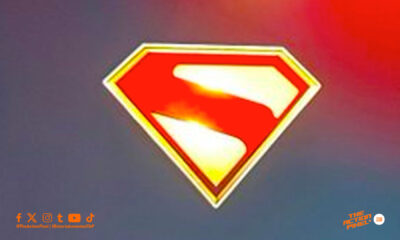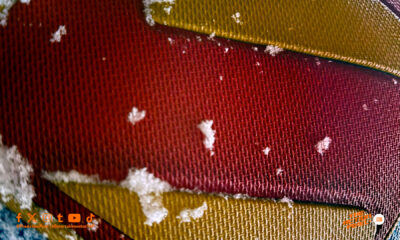Comics
Joker-variant cover Batgirl #41: Putting a brave smile on bad issue
Published
9 years agoon
![]() Of course when news hit the DC Universe of the Rafael Albuquerque cover being pulled from June’s Joker Variant cover, it seems highlighted an age ol’ fissure in the Comic Culture Universe.
Of course when news hit the DC Universe of the Rafael Albuquerque cover being pulled from June’s Joker Variant cover, it seems highlighted an age ol’ fissure in the Comic Culture Universe.
In celebration of the Joker’s 75 years on the DC imprint, DC Comics have been doling out Joker-variant covers across DC titles including Batman #41 and Batgirl #41. It was Albuquerque’s cover, a homage to The Killing Joke graphic novel, however, that has a minority really on edge.
And it usually is a simple thing as a tribute to classic Joker / Batman The Killing Joke that seethes into something ugly, whether through hyperbole, overly-simplistic generalisations and political correctness in overdrive. But to understand the issue’s issue and why a simple render has become the tinder to such a heated debate, one really has to understand the different strands at play revolving around the cover.
Creative Controlled
This is probably the least looked upon of all the issues, and to some point speaks on exactly how much power the creative has working in such colossal brands such as Marvel and DC. Variant covers are usually made for special limited edition prints of comic titles alongside the original covered versions to add a bit of ‘spice’, so fans can buy and collect different versions of the same comic.
It’s a unique marketing tool for moving copies of comics, and it helps add a unique stamp for revered artist to make their stamp and bring their own fan-base to purchase a title. Artist like Alex Ross and Phil Noto will often bring with them a solid fan-base when they do their special one off variants for various titles across the likes of Image Comics, DC and Marvel.
But the issue comes with creative control. A lot of the times, as it turns out, comic artists involved with a comic series and their original covers have little to no control over who creates the variant covers. This is not particularly a ‘bad’ thing. But when you consider an artist, who is not as familiar or invested in the trajectory of a comic series as the serialised writers and artists attached to it, one can understand how a particular variant may be adverse to the original artist’s intended message comic narrative. Especially when you consider the medium of the comic, from cover-to-cover, to be the ‘experience’ that the creative wants to have control over. This as such is taken out of the original artist’s hands by publishers like DC and placed into another artist’s hands. This lack of creative / narrative sync seems to be some people’s issue with Albuquerque’s cover, which is explained, and leads into the second point one needs to consider…
Feminism Bloodied
Apparently the Joker-variant Batgirl #41 cover pushed back women in comics about two decades or more. And the thing is it may not be as much as the render itself but what the render pays homage to. The Killing Joke, which Albuquerque sights as inspiration for his variant cover, may be what has gotten people riled up. In the classic Alan Moore-penned 1980’s comic, the Joker shoots Barbara Gordon (Batgirl) in the back, effectively turning her into a paraplegic and show photos of her bleeding out to torture her father Commissioner Gordon.
Now this is a hot topic as it is often said in this era of the comic violence towards women have been a device to evoke righteous anger and purpose in male protagonist, reducing women to nothing more than a plot device to be used, devoured and destroyed as the comic writer sees fit. This argument is further bolstered by the infamous statement made by The Killing Joke‘s editor Len Wein at the time when more approached him with the general synopsis for the graphic novel and what was to become of Barbara Gordon:
yeah, okay, cripple the bitch
And from there, there seemed to be no effort to resurrect the heroine. But since then the Batgirl title has evolved into a heroin that is both driven and empowered, an image that took years to cultivate. Consider Barbara Gordon as the Oracle, the info-tech wizard that helped even Batman get info he himself had trouble finding.
So while most saw the variant cover as a tribute to a defining, yet historical narrative, a few others viewed the cover as a step backward to a time where comic women were simple plot devices to move a narrative along. But can one cover undo years of cemented Batgirl history? And if so what would that say about the new Batgirl they have erected all these long years? By pulling the cover they may have undermined the strength of the Batgirl brand to stand up against historical context and scrutiny.
With the nature of comic variants, hell, even original comic covers, at times don’t line up with a comic’s narrative. So the Joker-variant shouldn’t be such a disparaging issue if people looked at it for what it is: a historical view of Batgirl, particularly in relation to the Joker and, in a wider sense, the past female-male comic character dynamic. This, juxtaposed with the modern empowered Batgirl within the panels, well could have been a nice play on how far the comic universe has advanced. And that’s the issue. So iconic was The Killing Joke that no matter how many narratives are rendered, the graphic novel still hangs on the periphery of the minds of comic fans. And being such a disturbing narrative, both sides of the border gravitate towards it in some form or the other.
PC-Pressure
The customer-brand dynamic is changing. We see how integral a part the internet plays in swaying how a product is effectively sold to us. When Avengers had their first trailer leaked, they release it officially days before it was slated to be. And when a small minority took to Twitter decrying the controversial cover, the artist and DC Comics went to pull the cover from print, with DC stating
…Regardless if fans like Rafael Albuquerque’s homage to Alan Moore’s THE KILLING JOKE graphic novel from 25 years ago, or find it inconsistent with the current tonality of the Batgirl books – threats of violence and harassment are wrong and have no place in comics or society.
Now this statement oozed PC-dribble, as any narrator will tell you, every good story there is has conflict and resolution, and where there is friction, your bound to have a fight or two. But the issue comes from the fact one could assume as long as a huge enough minority push a hot-button issue like gender, race, sexual orientation, they can pressure comic publishers to change the format as they see fit. DC Convergence and impending new solicitations seek to take on a more liberal approach to modern comic book narratives, introducing what would be considered non-traditional heroes (ie women, black guys and gay guys). This is surely welcomed for new innovative, yet-to-be-told stories. But if a small minority is allowed free range to press the internet-panic button, it could set a bit of a bad precedent for the comic in general. Like supposed a character is deemed stereotypical from a one-off panel or cover, it would go to reason that a big enough anti-comic Twitter campaign could have a whole issue shut down or rearranged to suit the minority. Bad precedent.
And don’t think I have forgotten about the ‘ist’ people who use issues like this Variant cover to spout off their bigotry and hatred. Effectively ripping the Joker-variant inadvertently gives these people power too. And while some may feel strongly about the Batman #41 variant, in the end it has always been a portrayal of a Batgirl that was, a part of history that should be remembered as the writers and artists of today continue to plot their course towards a more confident, a more self-reliant Batgirl.
![]() Think about it, why aren’t we having the same issue with Batgirl’s Purple Rain cover. Wasn’t that hit song from Prince on the album talking about female masturbation? Does it mean Batgirl is a “A sex fiend… masturbating with a magazine”? Of course not.
Think about it, why aren’t we having the same issue with Batgirl’s Purple Rain cover. Wasn’t that hit song from Prince on the album talking about female masturbation? Does it mean Batgirl is a “A sex fiend… masturbating with a magazine”? Of course not.
At the very least, I would settle on a compromise. Sometimes changing a few variables creates an all new image. Example: imagine the Joker variant as is except that Batgirl’s expression isn’t one of sheer terror but one of disgust. That would intrinsically imply more control on her part despite being seemingly held hostage.
In any case this simple cover has exposed under the thin layer of advanced characters and stories that both pros and cons quickly revert to the old ways of thinking when it comes to male-female dynamism, because no matter how advanced the comic universe gets, they are still moulded by flawed hands and interpreted by flawed minds.
Blogger, comic book and anime fan. FPS addict. All very convenient. Known to do storyboards and motion graphics when he's really busy.
You may like
-


DC’s no. 1 chrome-dome Peacemaker circles the block a second time as production begins on Season 2
-


DC Comics’ “Superman: Legacy” unveils official logo
-


Arthur Fleck finds a dance partner in crime in “Joker: Folie à Deux” official teaser trailer
-


Joker: Folie à Deux first poster gives the Joker a worthy dance partner
-


The very first image from James Gunn’s “Superman” gets released as principal photography begins.
-


DC’s “Joker: Folie à Deux” rings in Valentines with new images and release date announcement